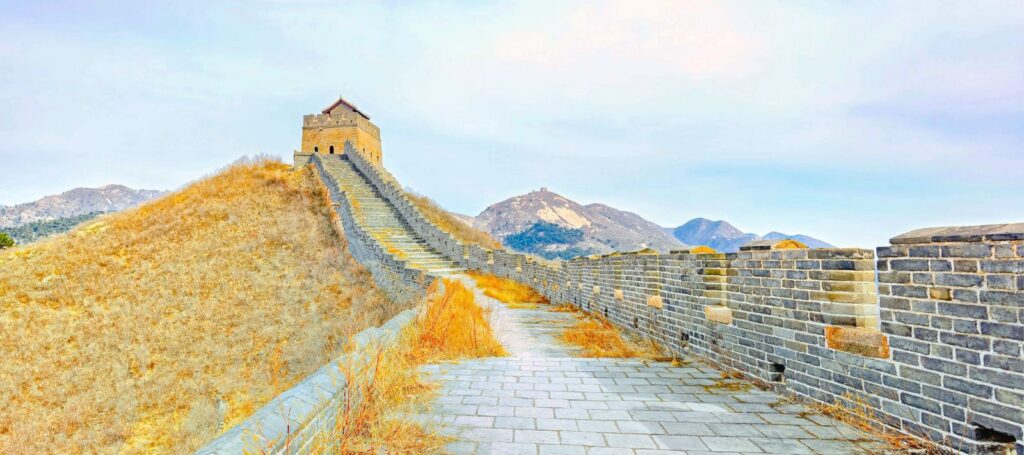Jiumenkou Water Great Wall is located in the suburbs of Suizhong County, at the border between Liaoning and Hebei provinces. It was first built during the Northern Qi Dynasty and expanded in the early Ming Dynasty (1381). The wall connects to the Great Wall in the direction of Shanhaiguan in the south and extends north to the Jiujiang River, where a massive bridge over the river was constructed, hence the name due to the nine water-discharging gates beneath the bridge.
Standing on the bridge, one can visit this unique ancient military fortress, explore the military facilities built inside the Great Wall tunnels, and ascend to the ridge of the Great Wall to enjoy a panoramic view of the surrounding mountains, walls, and beacon towers. The highlights of visiting Jiumenkou Great Wall scenic area include exploring the Great Wall tunnels and the bridge, as well as hiking the Great Wall, which can be comfortably completed within half a day.
Upon entering the scenic area towards the bridge, visitors can follow the signs to visit the Great Wall tunnels first. The tunnel, stretching for one kilometer and leading directly outside the Great Wall, was overseen by a Ming Dynasty general with the purpose of allowing soldiers to secretly flank the enemy. Within the tunnel, one can see stone rooms such as training rooms, kitchens, command rooms, and weapon rooms, with the scenic area also featuring bronze soldier statues to recreate the ancient scenes.
After the tunnel visit, one must return to the river bridge, ascend the steps to the broad bridge, and observe the massive water prison and the crenelations on both sides, with the Jiujiang River flowing gently beneath the archways. This tall and sturdy bridge serves both as a river crossing and a part of the Great Wall’s fortifications.
This aquatic fortress was an important gateway between the pass and the outside world, and between 1922 and 1924, warlords from the Zhili and Fengtian factions fought here. Continuing up the mountain past the bridge, one encounters a section of the Great Wall similar to Badaling, stretching along the mountain ridge. The section of the Great Wall within the scenic area has been restored, allowing visitors to walk confidently on the sturdy stone path and enter several watchtowers. However, due to the Great Wall’s ancient age and exposure to battles, the ‘wild Great Wall’ in the distance is now in ruins and not accessible, only viewable from afar as historical scars lying quietly on the ridge.
The scenic area also includes smaller attractions such as a rare bird observation park and Ci’en Temple, and during the flood season, visitors can row boats on the Jiujiang River. Moreover, Jiumenkou Great Wall scenic area is not far from Suizhong Dongdaihe Tourism Area and is relatively close to Qinhuangdao Shanhaiguan, making it convenient to visit these places together. Especially between May and September, it is very pleasant to walk on the beaches, enjoy seafood, and climb the Great Wall in this area.
Opening hours: 08:00-16:00 all year round.
Preferential policies: Children under 1.3 meters (not including 1.3 meters) are free; Elderly over 70 years old (including 70 years old) with ID or senior citizen card are free; Elderly between 60 and 69 years old (including) with ID or senior citizen card receive discounted tickets; Students under 1.3 meters (not including 1.3 meters) receive discounted tickets.
Students 3 meters (inclusive) and above with student IDs can enjoy discounted tickets.
Military personnel: Active-duty military personnel with officer certificates can get discounted tickets.
Disabled people: Those with disability certificates can obtain discounted tickets.
Supplementary note: The above information is for reference only. Please refer to the information disclosed by the scenic spot on the day for specific details.
Must-see tips:
1. According to the feedback of many tourists, you may encounter monks inside and outside the scenic spot inviting you to offer incense. Please don’t trust them easily, otherwise you may be deceived out of a lot of money.
2. There are local people selling self-grown fruits and melons inside the scenic spot. The prices are reasonable and the taste is good. You can give them a try.
3. When taking a taxi locally, negotiate the price with the driver in advance. Try not to take unlicensed taxis to avoid being overcharged.


